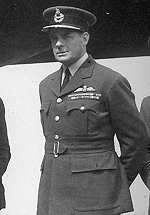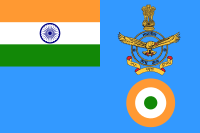Roderick Carr
Air Marshal Sir Charles Roderick Carr, KBE, CB, DFC, AFC (31 August 1891 – 15 December 1971) was a senior Royal Air Force commander from New Zealand. He held high command in the Second World War and served as Chief of the Indian Air Force.
Sir Roderick Carr | |
|---|---|
 Sir Roderick Carr | |
| Born | 31 August 1891 Feilding, New Zealand |
| Died | 15 December 1971 (aged 80) RAF Hospital Uxbridge, England |
| Allegiance | United Kingdom |
| Service/ | Royal Navy (1914–18) Royal Air Force (1918–47) |
| Years of service | 1914–1947 |
| Rank | Air Marshal |
| Commands held | Commander in Chief, Air Headquarters India (1946) No. 4 Group (1941–45) No. 61 Group (1940) RAF Brize Norton (1939) |
| Battles/wars | First World War Second World War |
| Awards | Knight Commander of the Order of the British Empire Companion of the Order of the Bath Distinguished Flying Cross Air Force Cross Mentioned in Despatches Order of St. Anna, 2nd Class with Swords and Bow (Russia) Order of St. Vladimir, 4th Class with Sword and Bow (Russia) Commandeur de la Légion d'honneur (France) Croix de guerre (France) |
| Other work | Divisional Controller, Ministry of Civil Aviation |
Military career
Educated at Fielding School and Wellington College, New Zealand, Carr was commissioned as a temporary flight sub-lieutenant in the Royal Naval Air Service in July 1915.[1] He saw action as a spotter at the Battle of Loos in October 1915 during the First World War.[1]
In 1919 Carr went to Russia to fight on the anti-Bolshevist side in the civil war, where he won his Distinguished Flying Cross for action against the enemy. The citation was as follows:[2]
On the 17th June, 1919, this officer flew a scout machine over the enemy aerodrome at Puchega, at an average height of only 50 feet, for thirty minutes. During this time he succeeded in setting fire to a Nieuport enemy machine, to a hangar which contained three aeroplanes (all of which were destroyed), drove all the personnel off the aerodrome, and killed some of the mechanics.
In 1921 Carr was a part of Ernest Shackleton's final Antarctic expedition. On his return, he was granted an RAF short service commission in the rank of flying officer.[2]
In 1927, Carr and Flight Lieutenant L.E.M. Gillman attempted a non-stop flight to India, in a specially modified Hawker Horsley aircraft carrying much extra fuel and taking off at a weight of over 14,000 lb (6,350 kg). Carr and Gillman took off from RAF Cranwell on 20 May 1927, but ran out of fuel en route, ditching in the Persian Gulf near Bandar Abbas, Iran. Despite this they had covered a distance of 3,420 mi (5,506 km), which was sufficient to set a new world distance record, but which was beaten in turn within a few hours by Charles Lindbergh's solo Atlantic flight between New York and Paris in the Spirit of St. Louis, covering 3,590 mi (5,780 km).[3]
During the Second World War, Carr served in Bomber Command as Air Officer Commanding No. 4 Group RAF for the majority of the war. Carr was promoted and appointed Deputy Chief of Staff (Air) at the Supreme Headquarters of the Allied Expeditionary Force in the final stages of the North West Europe Campaign. His war services were recognised with the award of Commander of the Legion of Honour and the Croix de Guerre by the President of France.[4] Sir Roderick later became Air Officer Commanding, India Command ("Chief of the Indian Air Force").
In retirement, he lived in Bampton, Oxfordshire.[1] He died at RAF Hospital Uxbridge.[1]
References
- "Carr, Sir (Charles) Roderick". Oxford Dictionary of National Biography. Retrieved 24 February 2016.
- "Air Marshal Sir Roderick Carr". Air of Authority – A History of RAF Organisation. Retrieved 24 February 2016.
- Mason, Francis K. Hawker Aircraft since 1920. London:Putnam, Third edition, 1991. ISBN 0-85177-839-9., pp.12–13.
- M. Brewer, 'New Zealand and the Legion d'honneur: Officiers, Commandeurs and Dignites', The Volunteers: The Journal of the New Zealand Military Historical Society, 35(3), March 2010, p.137.
External links
| Wikimedia Commons has media related to Roderick Carr. |
| Military offices | ||
|---|---|---|
| Preceded by Meredith Thomas |
Commander in Chief, Air Headquarters India 1946 |
Succeeded by Sir Hugh Walmsley as Commander in Chief, RAF India |
| Preceded by Arthur Coningham |
Air Officer Commanding No. 4 Group 1941–1945 |
Succeeded by John Whitley |
| Heraldic offices | ||
| Preceded by Sir Herbert Heath |
King of Arms of the Order of the British Empire 1947–1968 |
Succeeded by Sir George Gordon-Lennox |
